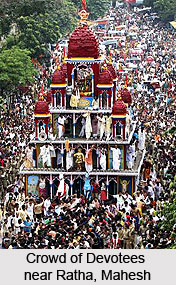 Ratha Yatra of Mahesh is the most ancient Ratha Yatra or chariot festival in West Bengal and the second oldest chariot festival in the entire country and it is being observed since the year 1397. It continues for an entire week and is a large fair is organised during the time of the Ratha Yatra of Mahesh. Lakhs of tourists visit the fair and the festival, and eagerly participate by pulling the long ropes or `Roshi` connected to the holy chariots of Lord Jagannath, Balaram and Subhadra, completing the journey to Serampur Gundicha Bari from the temple and back.
Ratha Yatra of Mahesh is the most ancient Ratha Yatra or chariot festival in West Bengal and the second oldest chariot festival in the entire country and it is being observed since the year 1397. It continues for an entire week and is a large fair is organised during the time of the Ratha Yatra of Mahesh. Lakhs of tourists visit the fair and the festival, and eagerly participate by pulling the long ropes or `Roshi` connected to the holy chariots of Lord Jagannath, Balaram and Subhadra, completing the journey to Serampur Gundicha Bari from the temple and back.
The region of Mahesh exists in Hooghly District in the eastern Indian state of West Bengal, close to the town of Serampur which is under the jurisdiction of Serampore Police Station, Rishra. Rathajatra of Mahesh is not only the oldest chariot festival of Bengal but it also the grandest one in this part of the nation. Lord Jagannatha is carried inside the chariot till the Serampur Gundicha Temple and it is placed there till `Ultorath` or `Punarjatra`, as it is termed in West Bengal. Famous theatricians Girish Chandra Ghosh, Sri Ramakrishna Paramahansa and his wife Sarada Devi had paid visit to the Rathajatra of Mahesh.
History of Ratha Yatra of Mahesh
During the 14th century, a Bengali sage known as Drubananda Brahmachari visited Puri for the purpose of pilgrimage and he harboured a great wish to serve `bhoga` to Lord Jagannath with his own hand. However, he was prevented in doing so by the temple authority and therefore Drubananda made up his mind, to fast until death. But he heard the voice of Lord Jagannatha in his dream on the third day of his fast which told him to return to Bengal, particularly to the banks of Bhagirathi River near Mahesh.
 There, He would send the sage a neem trunk or `daru-brahma` and the sage must build the idols of Lord Jagannatha, Balarama and Subhadra with its wood. The Lord added that He was eager to receive Bhoga from the hand of his ardent devotee. Thereafter, Drubananda came back to Mahesh and commenced his `sadhana`. Then, the daru brahma appeared in front of him, amidst the waters, in a violent stormy and rainy night. The sage plunged into the water and retrieved the neem trunk after which he created the idols of the Holy Trinity of Lord Jagannatha, Balarama and Subhadra and established a temple.
There, He would send the sage a neem trunk or `daru-brahma` and the sage must build the idols of Lord Jagannatha, Balarama and Subhadra with its wood. The Lord added that He was eager to receive Bhoga from the hand of his ardent devotee. Thereafter, Drubananda came back to Mahesh and commenced his `sadhana`. Then, the daru brahma appeared in front of him, amidst the waters, in a violent stormy and rainy night. The sage plunged into the water and retrieved the neem trunk after which he created the idols of the Holy Trinity of Lord Jagannatha, Balarama and Subhadra and established a temple.
Sri Chaitanya left for Puri after he embraced `sanyas` and reached the temple constructed by Drubananda at Mahesh. There, he was lost in deep meditation or `samadhi` and much later he was requested by Drubananda to look after the temple and its deities. Therefore, Kamalakar Piplai who was the fifth amongst the Twelve Gopalas of Mahaprabhu the `Sebait` of the Temple. Drubananda Brahmachari died after a few days.
Different Chariots at Ratha Yatra of Mahesh
The current temple of Kamalakar had been built by Nayanchand Mallik of Pathuriaghata near Kolkata in the year 1755. In ancient days, the temple as well as the Ratha were absent from this spot. No information has been derived about the very first Ratha. Once a devotee of Baidyabati had donated a ratha to the temple and another ratha had been offered to the temple by Krishnaram Basu, the grandfather of Balarama Basu who was one of the renowned disciples of Sri Ramakrishna Paramahansa. The Ratha had been renovated by his son Guruprasad Basu during the year 1935. Yet another holy chariot had been prepared in 1852 by Kalachand Basu after the one repaired by Guruprasad was burnt. Once, somebody committed suicide inside the Ratha and therefore a brand new ratha was made by Biswambhar Basu in 1857. Unfortunately, this ratha was also burnt. During this time, Dewan Krishnachandra Basu had ordered for an iron chariot and this ratha exists even to the present-day. The chariot was 45 feet in height and possesses 10 iron wheels and the design of the ratha follows traditional Bengali or `Nabaratna` and it contains nine `churas`.
`Radharani`, the well-known novel composed by Bankim Chandra Chatterjee has elaborately explained the Rathajatra of Mahesh through his literary work.





